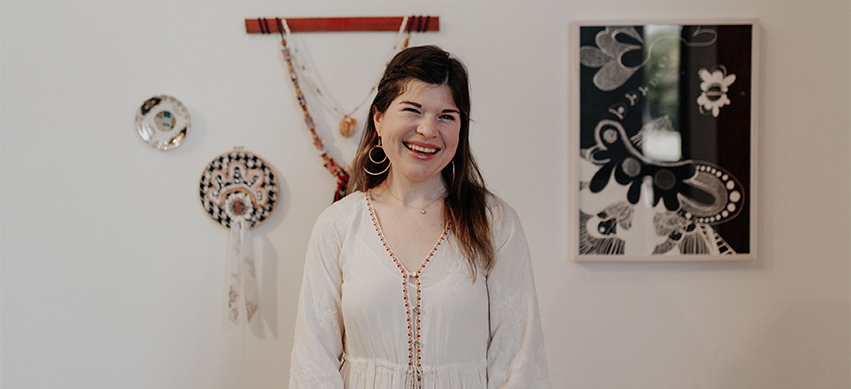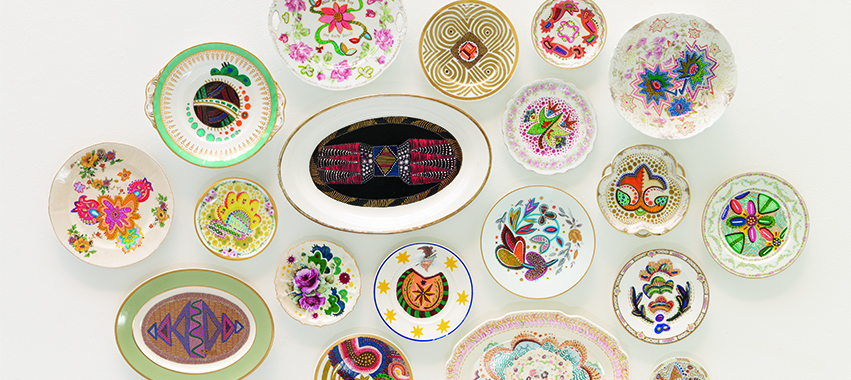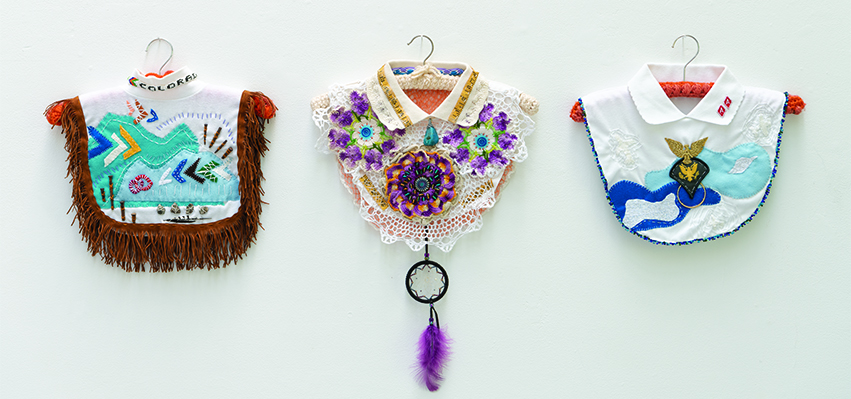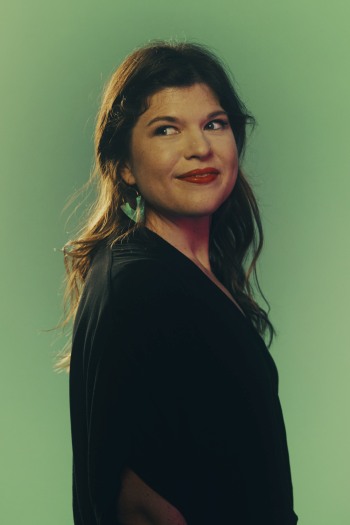
Earlier this year, I ran into a friend at an event. She was wearing bright, patterned fabric earrings with intricate stitching and beadwork. “Those have to be a Hattie Lee original,” I immediately declared. Though I’d only met Lee briefly (and had no idea she made earrings!), her style was distinctive in a way that I had never before encountered. I quickly realized, as my friend nodded enthusiastically at my hunch, there is clearly something unmistakable about her work.
On her website, Lee reflects on what fuels her practice: “histories on many spectrums—ancestral, artistic, material, personal and cultural.” Perhaps this is what makes her work so unique. It spans across mediums from painting to fiber art to antler art and more, each multifaceted thread pointing back to her journey with her Cherokee heritage and a life spent falling in love with the vast richness of human cultures.
The Fuel
Hattie Lee grew up on the prairie of southwestern Kansas, and occasionally had the chance to visit her mother’s hometown: Peoria, Illinois. “My hometown is about 600 people,” she notes. “To me, Peoria is the big city!” As a homeschooler living on a farm, Lee was afforded unique opportunities for creativity. “I got to join in on all the adult painting classes,” she offers. Then, as now, she was curious and interested in more than one medium. Her paternal grandmother taught her to cross-stitch and sew, and allowed her to experiment. “I would get on the sewing machine and make weird little things out of fabric.”
After graduating with a degree in graphic design from Tabor College in Hillsboro, Kansas, Lee was hired to serve for three years in Thailand on a religious organization’s art team, distributing materials to indigenous peoples in Asia. This work involved a lot of travel and cultural research, and found her asking questions like: “What colors are important to you? What does red mean to this tribe?” This way of thinking about art—through a cultural lens—was eye-opening for her.
Many of the groups Lee worked with were ostracized by the ethnic majority. In Malaysia, for example, the Rohingya are a stateless Indo-Aryan ethnic group whose people have long struggled, in part due to their refugee status. “We would travel and meet with displaced Rohingya and ask… ‘Does this [drawing] look like your village? What would a Rohingya village look like? Do you sit on mats on the floor? What colors do you wear?’”
Within this cultural context, the importance of using or avoiding certain colors was key. “That fascinated me,” Lee points out. “Like white, for example. To us, that is purity and cleanness… But then in other cultures, it’s a funeral color. Where black might have that connotation for us, it doesn’t for them.”
During her work overseas, Lee eventually came to an important realization—it was time to return to the United States and focus on her own artistic development. “I wanted to feel more confident in fine art because I was coming from a graphic design background,” she explains. “I was doing fine art, which I always enjoyed. However, I wasn’t that confident in what I was doing.” That sentiment would change, but only after a transformative dive into her family’s ancestral history.

Embracing a Heritage
In 2018, Lee moved back to the United States to pursue a master’s degree at Bradley University. She was able to live with her maternal grandmother in Peoria—which provided an important link to their shared family history. Lee’s great-grandmother was a Cherokee woman from Oklahoma, and while her family had lost their connection to this lineage, living in her grandmother’s home sparked great curiosity. “Because of my cultural influences overseas, I was able to start researching my own cultural background when I came back… trying to rebuild that for myself since it had been kind of lost through the generations,” she remarks. “If I hadn’t had all those experiences with other cultures, I wouldn’t have known how to start that for myself.”
Armed with the knowledge of what kinds of questions to ask, Lee dove into this research—but had to rely on outside sources. “I’ve always really valued the fact that my family is Cherokee. I’ve always been proud of that and interested in it. I remember stories from my great-grandma,” she muses. “As a child, when she was still around, I didn’t know to ask her questions about our culture. And now I wish I could, but she’s not here.”
As Lee connected with her family’s ancestry, she became an official member of the Cherokee Nation and began to investigate Cherokee basketry and historic moccasin designs. Yet in her artistic practice, she remained focused on painting what she considered to be “practical,” such as landscapes. “I saw that as being more valuable. I was always taught that abstract art was not a good thing,” she offers. “In my very practical, rural Kansas upbringing, I always felt like it should be something relatable… a beautiful landscape that you could look at.”
It was only when she took a color theory class with Bradley University professor Heather Brammeier that Lee was encouraged to explore Cherokee tribal patterns, along with those from other cultures she had encountered. As she grew more comfortable with this new creative path, she was able to experiment during the final two years of her program.
Lee’s subsequent work reflects not only her Cherokee heritage, but the other cultures in her background, including Scottish and Swiss-German, as well as those she had become familiar with in her travels. “It’s always going to be an amalgamation of cultures… and I find beauty in that,” she reflects. After this meaningful and crucial change in direction, everything began to fall into place.

A Common Language
Lee’s work bursts with bright, colorful patterns. It feels fun. “Joy in my work is very important,” Lee agrees enthusiastically. “I love it when someone says, ‘I feel happy when I look at your work!’”
Over the years, she has picked up an assortment of indigenous artwork that resonates with her—for example, she’s very influenced by Hmong tribal art from the mountains of northern Thailand. “They use a lot of hot pinks and neon greens and very bright colors. I always loved seeing in the market all the patterns and stitchwork and embroidery... the vibrant pops of color,” she says. “When I travel, I’m collecting embroidery and beadwork and all kinds of things from different tribes.”
The mediums in which Lee works are as diverse as the traditions that influence her designs—ranging from traditional paintings to fiber art, to painted antlers and beyond. She also makes use of found objects, which can be seen in her design that was selected to be part of ArtsPartners’ Sky Art Peoria program, which places the work of local artists on area billboards. In this piece, she incorporated a necklace made by one of her friends, a Syrian refugee living in Turkey.
“I put it in this collage, just thinking about cultural influences and friendships—and how creative even just having a friendship is,” she suggests. “It brings a lot to the world when people from different communities and cultures can come together, learn more about each other and have friendship.”
Similar stories can be found in another new series, “dickies,” in which Lee repurposes her grandmother’s old false shirt fronts by incorporating them into hanging fiber art adorned with beadwork, feathers and found objects. In addition to using her grandmother’s belongings, she also incorporated doilies that belonged to Bradley professor Heather Ford’s grandmother—extending her cultural interests to her current community. “It’s important to me that I get to include things from my friends in Peoria or my friends from overseas,” she explains. “I always try to know the story behind the object… or at least who I got it from.”

Regardless of the medium, Lee says that all of her pieces speak “the same language.” Her paintings often look like stitchwork, for example, and her fiber work resembles her paintings. “I like to make it look like it’s beaded or stitched, even if it’s just a painted line,” she says. “I feel like they all relate to each other and I don’t have to choose.” Chuckling, she recalls going to graduate school and fearing that she would have to narrow her work to a single medium. “I love that they all still relate to one another,” she points out.
“It’s always been intermixed, although now I would say I’ve finally found how I can merge it all. I don't have to stick with just thread and fabric… I can paint on fabric now, or I can paint something and then add fabric on top of it,” she observes. “I’m excited to continue exploring how all of them can be merged together.”
Spreading Joy
This year, Lee has been designated as the Emerging Artist for the Peoria Art Guild’s Fine Art Fair. Along with her Sky Art Peoria billboard and other projects, her rapid ascent in Peoria’s arts community has been as exciting and vibrant as her art. “I’m very humbled by all of the opportunities that have come along,” she says. “Many of these opportunities I didn’t even know existed before I came to Peoria, and I’m just excited to see how they continue.”
So what is next for Hattie Lee? “That is the big question,” she laughs. Though she isn’t certain, she plans to stay in Peoria for the time being while she applies to have her work featured in galleries. “I appreciate how close the arts community is here. People seem to look out for each other and share opportunities.”
Ultimately, she hopes those who bring her artwork into their homes will build their own stories around it. “I don’t necessarily intend people to know the entire story behind each piece from my perspective, but I hope something in it resounds with them and their story,” Lee notes. “Maybe it’s a color they really love for some reason in their childhood, so they bought my piece and that becomes a part of their story. I want them to be used and put somewhere that people appreciate them and make them joyful. I hope it brings joy wherever they go!” PM
- Log in to post comments

